When it comes to large trucks, safe driving tips must address:
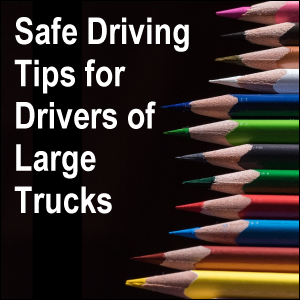 driving the trucks themselves and
driving the trucks themselves and- driving around the trucks.
For the purposes of this article, we will address only the first one.
Formerly, ShareTheRoadSafely.org addressed the second.(1)
What it Takes to Drive Large Trucks
Most people are familiar with 18-wheelers, but commercial motor vehicles (CMVs) range in size from small straight trucks to extremely large oversized trucks.
All professional truck drivers who drive commercial motor vehicles in the United States are required to have a commercial driver’s license (CDL) to operate trucks of certain Gross Vehicle Weight Ratings.
Depending on the kind of equipment you want to drive, additional endorsements may be required, such as to haul double and triple trailers or tankers.
Those desiring a CDL must pass a General Knowledge test and a Skills test, the latter of which proves that the driver can demonstrate
- stopping,
- backing,
- making turns,
- driving on city and highway roads, and
- weaving a truck through a “serpentine” course.
Of the classes of Commercial Drivers Licenses — Classes A, B and C — only holders of a Class A CDL can operate the large trucks.
Safe Driving: Space Cushion
Professional drivers who practice safe driving constantly monitor the “space cushion” around their trucks to make sure that they are not too close to other objects, whether stationary or moving.
By space cushion, we mean literally a cushion of space.
 Of the two boxes shown here, the one on the right has a larger space cushion, as pictured in red.
Of the two boxes shown here, the one on the right has a larger space cushion, as pictured in red.
The following illustration shows the directions around a truck that a professional driver must be concerned about:
- Height above (tunnels, overpasses and low clearances);
- Surface beneath (including sloped and uneven road surfaces, pot holes, speed bumps, road hazards, slipperiness, accumulated precipitation, weight restrictions, etc.);
- Forward space in front (including following distance and turning space);
- Rear space behind (including following distance of vehicles behind and backing space); and
- Space on both the driver side and passenger side (negotiating parking places, toll booths, tunnels and bridges).
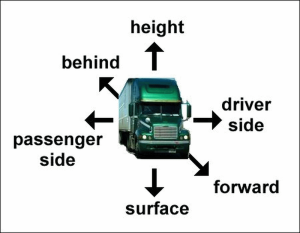
Safe Driving: Trip Planning
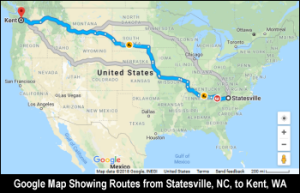 Knowing the terrain and travel conditions (which include the weather and flow of traffic) along your route before you leave can help you make safe driving decisions.
Knowing the terrain and travel conditions (which include the weather and flow of traffic) along your route before you leave can help you make safe driving decisions.
From a safe driving standpoint, it is good to know from the beginning of a trip if you can reasonably avoid situations where:
- the likelihood that you’ll be involved in an accident is higher or
- you’ll face long waits and impatient drivers.
Allow some extra travel time for
- traffic congestion,
- stop lights/signs,
- inclement weather,
- construction, and
- hilly or mountainous terrain.
There are numerous weather websites that feature forecasts for local areas.
For traffic conditions, we have used Google Maps’ traffic feature.
Simply visit Maps.Google.Com, type in a city name, and click on the “traffic” feature in the upper right hand corner of the map area.
The roads become color-coded according to the legend shown.
Some GPS units show not only road congestion but may suggest alternative routes where traffic is flowing at a better rate.
If a driver is hauling hazardous materials (often referred to as “HazMat”), he or she must take special precautions and perhaps take special routes.
Professional drivers must also always be aware of weight restrictions on bridges.
Performing pre-trip and post-trip inspections is required.
Repair what must be repaired before you make your trip.
Safe Driving: Speed
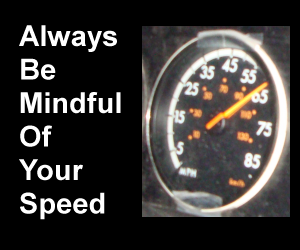 Speed plays an important role in driving a large truck.
Speed plays an important role in driving a large truck.
Professional truck drivers who practice safe driving do not drive so fast that they cannot safely stop their vehicles without being involved in a collision.
Remember: it takes you longer to accelerate and longer to brake a large truck than a car.
Always slow down in work zones, but don’t hang back to try to impede other vehicles with the size of yours.
The Federal Motor Carrier Safety Administration addresses the issue of driving too fast for conditions.(2)
“Know When to Slow” is the third tip in a list of “Tips for Truck and Bus Drivers”.(3)
Furthermore, according to the Fatality Analysis Reporting System (FARS) of the National Highway Traffic Safety Administration (NHTSA), speeding was the #1 factor involved in fatal large truck crashes in 2009.(4)
Safe Driving: Turns and Curves
Professional truck drivers who practice safe driving remember to slow down in turns (including entrance and exit ramps on major roads). Oftentimes, the posted speed limit on ramps is geared for smaller vehicles, not high-profile trucks. Failure to slow down sufficiently can lead to rollover accidents.
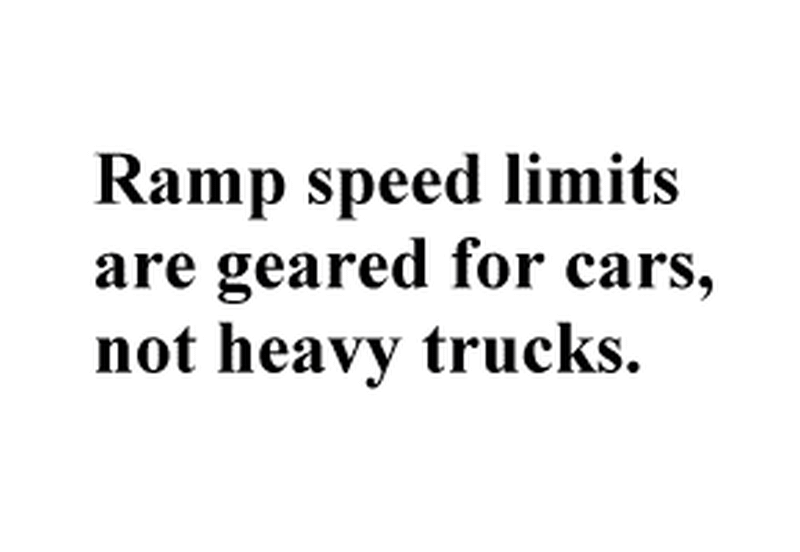 This animated image shows what happens when a large truck takes a ramp too fast. The text reads:
This animated image shows what happens when a large truck takes a ramp too fast. The text reads:
– Ramp speed limits are geared for cars, not heavy trucks.
– When approaching a ramp, drivers of big trucks must adjust their speed.
– When speed is properly reduced, the truck’s tires maintain contact with the road at all times.
– When speed is not properly reduced the truck’s tires will lose contact with the road.
– A rollover accident is inevitable!
– So slow down!
Whenever you are entering a curve in the road, you may need to slow down.
You will definitely need to slow down whenever you negotiate a turn.
We have seen a large truck turned over at the entrance ramp to an interstate because the driver took the turn too fast.
Rollover accidents can happen for numerous reasons including taking a curve too fast, overcompensating to get back on the road when your tires slip off the road, and high winds.
Allow for distance and speed of other vehicles when making a turn across traffic or into the path of oncoming traffic.
Never try to outrun an oncoming train at a railroad crossing.
Safe Driving: Stopping Distance
Semi-tractor trailers cannot stop on a dime. One of Newton’s laws of motion says: “An object in motion will stay in motion, unless an outside force acts upon it.”
Obviously, a loaded big rig takes longer to stop than a four-wheeled vehicle. However, professional drivers need to allow an even greater amount of total stopping distance based on conditions.
Driving in any of the following situations requires greater total stopping distance:
- at night,
- on secondary roads,
- in hilly or mountainous areas,
- along curvy roads, or
- whenever precipitation is falling or the roads have received precipitation.
The formula to calculate Total Stopping Distance is:
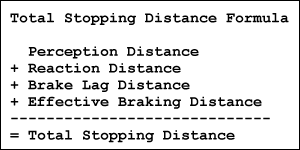
Braking and stopping distance are also affected by a truck’s weight.
There are significant differences in stopping ability between
- a truck with a loaded trailer,
- a truck with an empty trailer (aka “deadhead”), and
- driving just the tractor (aka “bobtail”).
You might think it would be easier to stop with just the tractor or with no load on the trailer, but we’ve found that just the opposite is true.
Safe Driving: Weather
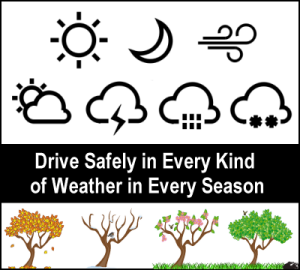 Professional truck drivers who practice safe driving know that stopping distance is also affected by weather.
Professional truck drivers who practice safe driving know that stopping distance is also affected by weather.
Professional truck drivers need to drive for conditions, allowing more room to stop when precipitation (rain, freezing rain, snow, ice pellets, etc.) is falling or accumulated on the ground.
The most dangerous situations are those when traction is lost, preventing the vehicle from responding to driver control of accelerating, braking or steering — such as might occur when hydroplaning, sliding on a patch of ice and jackknifing.
Drivers of large trucks should never use an engine brake (aka “Jake Brake”) in wet weather because traction could be lost.
In the winter, snow-covered roads can warm up during the day to partially melt off snow but freeze over again at night, creating treacherous conditions.
It is very difficult to drive on ice and most large trucks are not equipped to do it.
If the roads are below freezing and there is any rain, mist or fog, there is the possibility that “black ice” can form; it’s thin, nearly invisible and very dangerous.
We once encountered a set-up for black ice in the mountains of North Carolina.
Based on conditions, we advised our fleet manager of conditions, parked for the night and set out the next morning after the temperature had risen.
What did we miss?
In the night, freezing rain froze on the surface of the road, causing numerous cars and one large truck to literally slide off I-40, either on the shoulder side or into the median.
Other weather conditions can also be hazardous.
Fog, wind, blowing sand, blowing snow and bright sunshine can all present challenges to driving.
While strong winds are always a challenge to drivers of high-profile vehicles, cross-winds can be especially dangerous.
The secret to driving in any hazardous situation is to slow down and know when to stop.
We have had numerous situations when we’ve had to shut down.
We also refer to knowing when to stop in winter on our snow chains page.
Safe Driving: Momentum
Because of the size and momentum of their vehicles, professional truck drivers should learn to try to anticipate the actions of drivers of other vehicles around them. Part of this training involves looking down the road much farther than the typical driver does. This can be hard to do (if not downright impossible) on hilly or curvy roads.
The illustration below shows a large truck and car with lines drawn to show estimated distances that drivers may be looking ahead of their vehicles.

Safe Driving: Regarding Relying on GPS
Drivers of high profile vehicles need to be especially concerned about low clearances under bridges and through tunnels. We have read many articles about “professional” drivers who relied on a non-motor carriers’ GPS unit and peeled back part of the roof of their vehicles or got stuck or both. They ignored, to their own peril, the information clearly written on road signs and clearly documented in every motor carriers’ atlas.
One example is a driver who ignored an 11’3″ clearance sign and rammed his truck under a bridge.(5)
Safe Driving: Tailgating and Following Distance
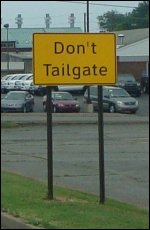 Drivers of large trucks and four-wheeled vehicles are both capable of following too closely behind the vehicle in front of them, a situation known as “tailgating.”
Drivers of large trucks and four-wheeled vehicles are both capable of following too closely behind the vehicle in front of them, a situation known as “tailgating.”
When proper space (remember that “space cushion” previously described?) is not allowed between vehicles, there is a greater likelihood of a collision taking place when the vehicle in the forward position brakes.
Professional drivers should never tailgate vehicles in front of them, no matter the size or weight of the vehicle.
It is possible to discourage others from tailgating you as you drive your truck.
It is also dangerous to practice cutting in between large trucks.
This action automatically reduces the following distance of the truck in the rear position and provides a set-up for a collision.
Safe Driving: Backing Up
The very nature of most professional drivers’ jobs call for them to back up their trucks frequently.
Backing occurs often at shipper’s and receiver’s docks as well as truck stops.
Professional drivers who practice safe driving know that backing accidents can be avoided by observing the familiar acronym
G.O.A.L.: Get Out And Look.
This is especially important when backing in from the driver’s “blind side.”
The position of the tandems under the trailer have a great deal to do with how tightly a turn can be made.
Examine the following illustration, which has been created to show the differences in turning radius between two trailers whose tandems are set differently:
- the “trailer” on the left has its tandems set all the way at the rear but
- the “trailer” on the right has its tandems pulled forward.
The lengths and angles of the two lines are the same; only the point at which the lines intersect has changed.
The numbers shown on the horizontal lines are in pixels, just for comparative purposes.
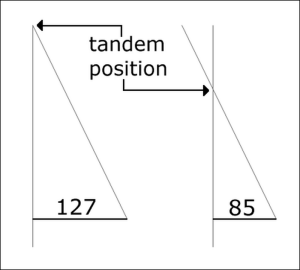
Both trailers swing about their pivots.
The driver whose trailer has tandems all the way at the rear will always know where the rear of his trailer is as he backs into a spot; however, there may not be the forward space required to make the turn.
Alternatively, the driver whose trailer has tandems pulled forward must be certain to clear objects on his right-hand (blind) side because of the pivot point.
In difficult backing situations, it is always helpful to have another pair of eyes “on the ground” (someone to spot or help you see).
If you need help seeing, don’t be afraid to ask for it.
However, be aware that there may be situations (especially in truck stop parking lots) in which the configuration of your rig simply will not make the turn required and you will need to search for parking elsewhere.
We have had this happen occasionally.
It is irritating not to be able to park in an empty spot, but it is better to give up trying to fit in where you can’t fit in than risk an accident.
Safe Driving: Hazards and Visibility
Some truck drivers have jokingly say that there are only two seasons of the year: winter and road construction.
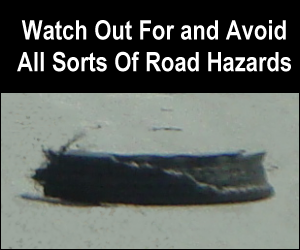 Regardless of what time of the year it is, drivers of all vehicles need to watch out for:
Regardless of what time of the year it is, drivers of all vehicles need to watch out for:
- road hazards — including ruts, uneven lanes, rough roads, and pot holes;
- objects in the road — including pieces of tires, trash, and animals (dead and alive);
- traffic and congestion;
- construction zones;
- lane restrictions;
- vehicles on the road and shoulder (including bicycles and motorcycles); and
- pedestrians walking along the road.
It can be very difficult to see some objects at night or in inclement weather.
For this reason, one must never out-drive one’s headlights and always be prepared to slow or stop.
A professional driver who practices safe driving works to keep his or her windshield, side windows and mirrors clean so as not to hinder his or her ability to see.
This can be challenging in any sort of inclement weather, especially in the winter when the roads have been salted.
Similarly, since you want to be seen by others, the surfaces of lights on your tractor and trailer — as well as reflective strips — need to be cleaned as often as necessary.
Although it can be time-consuming to clean glass and reflective surfaces, we believe that it is time well spent from a visibility standpoint.
Regarding the phrase “see and be seen,” professional drivers should use their lights appropriately.
We have found it beneficial to use lights not only when it is dark but also during dawn and dusk hours.
Review your trucking company’s recommendations regarding the use of low and high beams.
Flashers should be used whenever you encounter a sudden slow down in the normal speed of traffic or when you are traveling at speeds under 40 mph, such as might occur if you are pulling a heavy load up a steep hill.
Clean and wear whatever corrective lenses (contacts or glasses) or sunglasses have been prescribed to you.
Consider the use of polarized sunglasses to reduce glare.
Safe Driving: Distractions and Alertness
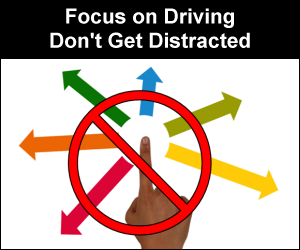 Drivers can allow themselves to be distracted by many things:
Drivers can allow themselves to be distracted by many things:
- use of electronics,
- pets,
- the radio,
- music/CDs/tapes,
- GPS units,
- a personal computer mounted on a laptop workstation,
- eating and drinking,
- cell phones,
- reading maps and directions,
- smoking, etc.
Professional drivers of trucks and buses are not allowed to text while driving. A proposed rule would also ban their cell phone use while driving. It is best to remember that when you’re driving, you need to concentrate fully on driving.
When it comes to concentrating on driving, it is easier to stay alert if a driver takes proper care of his health. This includes eating a well-balanced diet, engaging in adequate exercise and getting enough sleep. Many things can impede a driver’s ability to do these things, but they are all important.
Be aware of the effect of medication on driving. Never drink alcoholic beverages or take controlled substances in connection with driving a big rig.
Professional drivers should always wear their seatbelts.
Safe Driving: Blind Spots and the “No Zone”
The FMCSA describes “Large Blind Spots” around commercial motor vehicles as “No Zones”.(7).
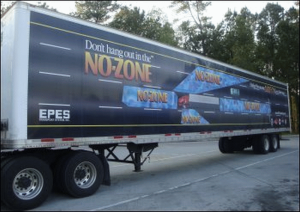 The trailer shown proclaims the message “Don’t hang out in the NO-ZONE”.
The trailer shown proclaims the message “Don’t hang out in the NO-ZONE”.
According to No-Zone Campaign Information, the goal of the No-Zone campaign “is to increase awareness of the No-Zones — danger areas like blind spots, around commercial vehicles, in which cars ‘disappear’ from the view of the truck or bus driver.
No-Zones are areas where crashes are more likely to occur.
 Some motor carriers place signs on their tractors in driver blind spots that actually state, “WARNING YOU ARE IN MY BLIND SPOT”.
Some motor carriers place signs on their tractors in driver blind spots that actually state, “WARNING YOU ARE IN MY BLIND SPOT”.
If your truck is governed or if you are surrounded by traffic, it may be difficult to encourage a driver who is traveling in your blind spot to move.
The only alternative we know of is to slow down and hope the other person keeps a steady pace or accelerates so as to move.
One way to help reduce the size of blind spots on a truck is to reasonably increase the number and location of mirrors on the tractor.
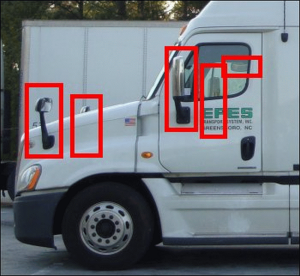 In this photo, you can see five mirrors outlined:
In this photo, you can see five mirrors outlined:
- two hood-mounted mirrors (driver and passenger sides);
- two folding side mirrors (driver and passenger sides); and
- a mirror mounted above the window on the passenger side to see vehicles on that side of the truck that may or may not be visible in the other two mirrors on that side.
One can have all the mirrors in the world, but they won’t do any good unless you look at them regularly to monitor traffic.
Your company will probably have recommendations on how often you should turn your head (not just your eyes) to look at your mirrors.
Safe Driving: Tires and Brakes
Your truck’s tires should always be inflated to optimum levels.
Be on the lookout for wear, embedded objects and cracks.
Some trailers have tire pressure monitoring systems which “re-inflate” tires that appear to be flat upon inspection.
Brakes must be kept in proper adjustment.
While many drivers rely upon their company’s shops to keep their brakes properly adjusted, it is helpful if they personally know how to adjust them.
Safe Driving: Conclusion
An article listing safe driving tips would be incomplete without a reference to the top 10 factors coded in fatal large truck crashes and encouragement to reduce those factors in your work.
A .pdf file on the Federal Motor Carrier Safety Administration’s website entitled “2009: Historic Truck Crash Declines” lists on page 21 the top 10 factors involved in fatal truck crashes.
If you reduce (or preferably eliminate) these factors in your work, you will go a long way toward safely driving your truck.(4)
![]() Money saving tip: Many of us may have what Vicki’s mom dubbed “The Superman Mentality,” which she meant as an attitude that nothing bad can happen to us no matter how bad our behavior.
Money saving tip: Many of us may have what Vicki’s mom dubbed “The Superman Mentality,” which she meant as an attitude that nothing bad can happen to us no matter how bad our behavior.
It’s like the person is immune to the negative consequences of his or her bad actions.
When a person with this attitude actually receives negative consequences for one or more of their bad actions, it comes as a surprise.
But it shouldn’t.
Actions have consequences.
The consequences may not be immediate, but they come sometime.
They may affect you personally; they may affect others.
But they come.
When it comes to safe driving, a consistent investment in good behavior or actions can help keep (as much as you can control) negative consequences minimized in your life.
Of course, accidents do happen even to the safest of drivers.
But you can minimize the likelihood of those taking place by being cautious and not doing tasks too quickly.
Certain organizations, trucking associations and trucking companies honor drivers who have long histories of being accident-free.
Aim to be among those so honored one day.
Return from Safe Driving Tips for Drivers of Large Trucks to our Truck Operations page or our Truck Drivers Money Saving Tips home page.
References
1. www.sharetheroadsafely.org/ (no longer online)
2. www.fmcsa.dot.gov/safety/driver-safety/cmv-driving-tips-too-fast-conditions
3. www.fmcsa.dot.gov/ourroads/tips-truck-and-bus-drivers
4. www.fmcsa.dot.gov/facts-research/media/webinar-10-09-29-slides.pdf
5. www.thebostonchannel.com/r/21709523/detail/ (no longer online)
6. www.fmcsa.dot.gov/sites/fmcsa.dot.gov/files/docs/webinar-10-09-29-slides.pdf
7. www.fmcsa.dot.gov/ourroads/large-blind-spots










